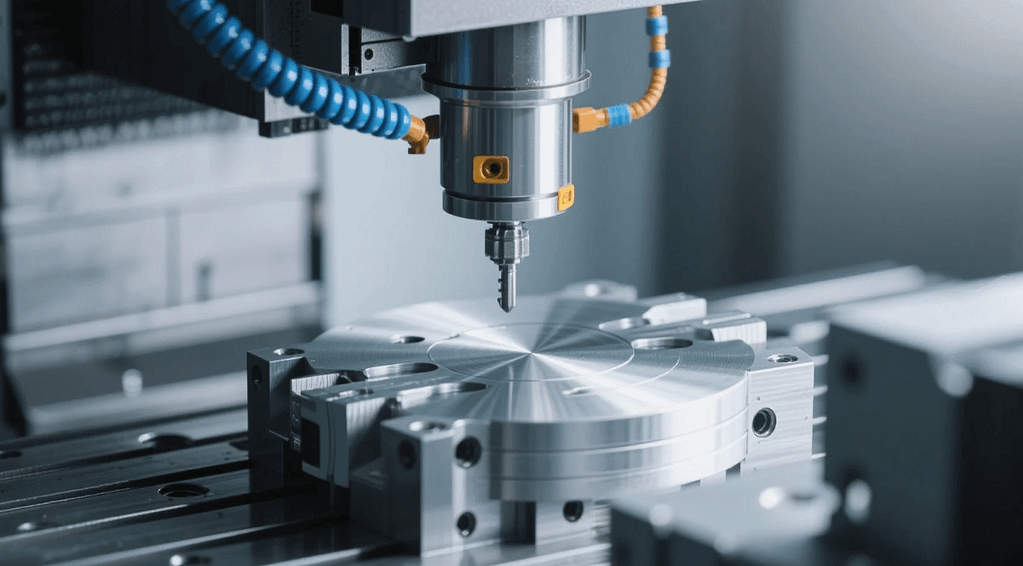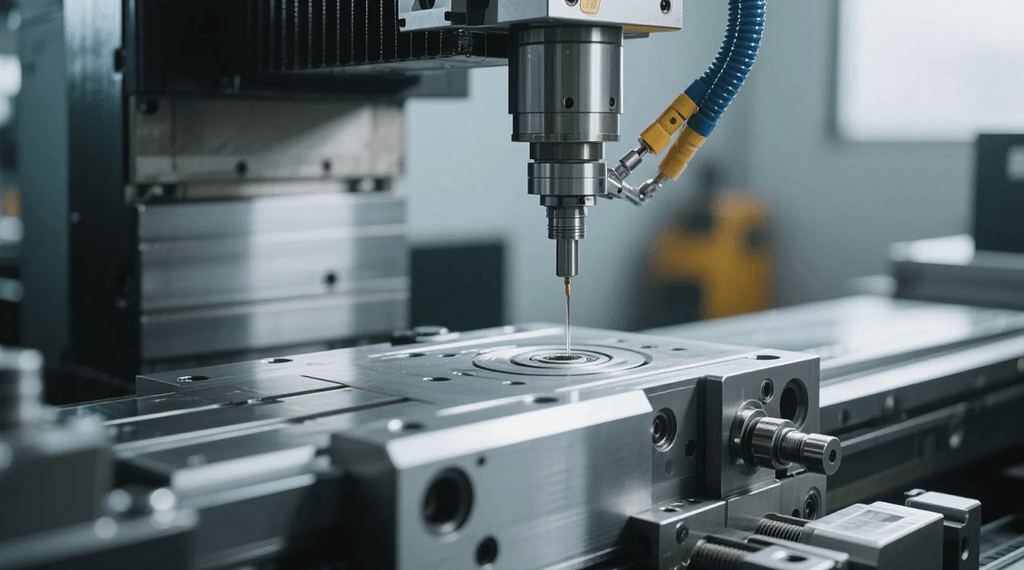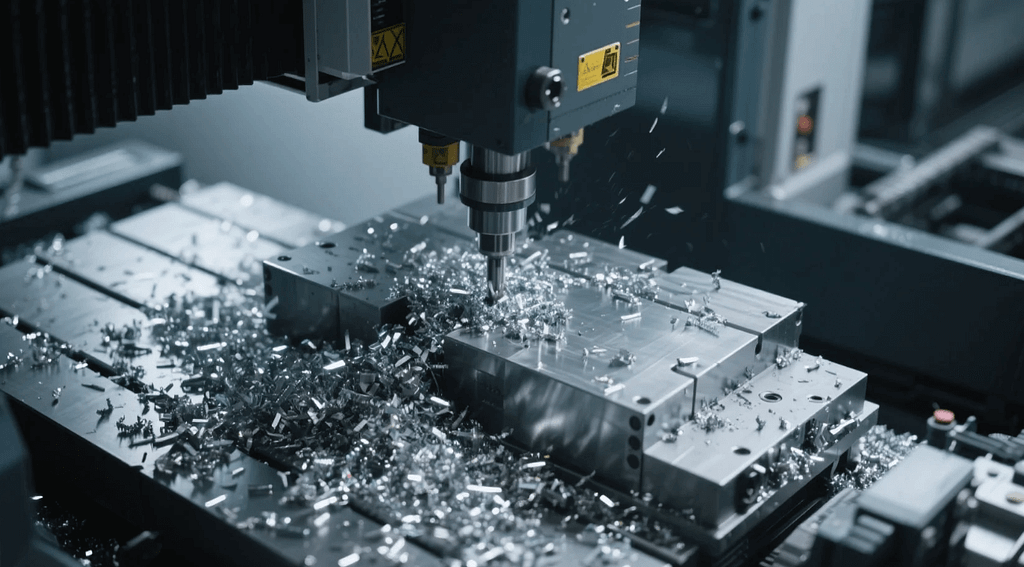In the rigorous world of aerospace, every component, from the smallest fastener to a critical engine part, must perform flawlessly under the most extreme conditions. The margin for error is virtually nonexistent, demanding an unparalleled level of precision and reliability in manufacturing. This is precisely why CNC machining for aerospace has become an absolutely indispensable technology. It’s not merely about cutting metal; it involves meticulously crafting mission-critical parts with tolerances so tight they defy conventional measurement, utilizing materials engineered for incredible strength and resilience. This article will delve into the essence of CNC machining for aerospace, highlighting its unique characteristics, its profound advantages, and its pivotal role in the creation of advanced industrial models. For businesses, like CAPtec, and others serving the aerospace sector with high-fidelity prototypes and essential components, understanding this specialized field is fundamental to unlocking innovation, ensuring airworthiness, and navigating the complexities of modern air and space travel.
The Non-Negotiable Demands of CNC Machining for Aerospace

The aerospace industry operates under an unwavering principle: absolute safety and uncompromising performance. From commercial airliners safely transporting millions globally to cutting-edge spacecraft exploring the cosmos, every single part must function without fail under immense stresses, extreme temperatures, and volatile environments. This unrelenting demand is precisely where CNC machining for aerospace distinguishes itself. It transcends standard machining by integrating an even higher degree of control, validation, specialized expertise, and stringent regulatory compliance to meet the aerospace industry’s incredibly demanding specifications. This includes achieving micron-level accuracy, ensuring exceptional surface integrity, maintaining full material traceability, and expertly working with some of the most challenging, high-performance materials known to engineering.
Pillars of Excellence in CNC Machining for Aerospace
Achieving the pinnacle of CNC machining for aerospace isn’t simply a matter of owning advanced machines; it requires a meticulous synergy of specialized equipment, highly refined processes, and unparalleled human expertise, all operating within a rigorous quality framework.
Ultra-Tight Tolerances and Geometric Precision
The most defining characteristic of CNC machining for aerospace is its consistent capability to hold exceptionally tight tolerances, frequently measured at sub-micron levels. For example, a critical engine component might demand a bore diameter accurate to within a few thousandths of a millimeter, or a complex structural bracket might need precise angles and contours to distribute stress evenly without failure. Achieving this remarkable accuracy relies heavily on:
- Advanced Multi-Axis CNC Machines: These include 5-axis, 7-axis, and even 9-axis machines, allowing highly complex geometries to be machined in a single setup. This significantly minimizes human error from re-fixturing and ensures seamless transitions between intricate surfaces, which is crucial for parts like turbine blades or airframe components.
- Thermal Management Systems: Temperature fluctuations can cause material expansion or contraction, directly impacting precision. Superior aerospace machines often incorporate sophisticated thermal compensation systems to maintain accuracy in dynamic machining environments, ensuring consistent part dimensions.
- Vibration Dampening and Rigidity: Even minuscule vibrations can negatively affect surface finish and dimensional accuracy. High-end aerospace CNC machines are engineered with extremely rigid structures and often incorporate active dampening systems to eliminate chatter and unwanted movement, vital for precision and tool life when cutting tough materials.
- Integrated Metrology and Feedback: Many advanced machines incorporate in-process probes and laser scanners for continuous verification of part dimensions. This real-time feedback loop allows for immediate adjustments, ensuring parts remain within specified tolerances throughout the machining process, and reducing scrap rates.
Flawless Surface Finishes and Subsurface Integrity
Beyond mere dimensional accuracy, the surface finish of aerospace components is critically important for their performance, longevity, and resistance to fatigue. A perfectly smooth surface reduces friction, improves aerodynamic efficiency, and prevents stress concentrations that could lead to crack initiation and propagation. CNC machining for aerospace achieves these exquisite finishes through:
- Optimized Tool Paths and Cutting Parameters: Sophisticated CAM (Computer-Aided Manufacturing) software generates highly refined tool paths that minimize cutting forces, ensure consistent material removal, and create optimal surface textures. Precise control over feed rates, spindle speeds, and depth of cut is paramount.
- Specialized and High-Performance Tooling: Diamond-tipped tools, ceramic inserts, and custom geometries are frequently employed to achieve superior finishes and extend tool life when machining hard aerospace alloys, which are notoriously difficult to work with without inducing excessive heat or tool wear.
- Controlled Cutting Environments: Precise control of cutting fluids (often specific, aerospace-approved coolants) and efficient chip evacuation prevents material re-cutting, excessive heat buildup, and surface contamination, all of which can significantly degrade surface quality and material integrity.
- Subsurface Integrity Assessment: It’s not just the visible surface; the machining process must not induce micro-cracks, tensile residual stresses, or alter the material’s crystalline structure beneath the surface. Such alterations could compromise the part’s long-term fatigue life, so careful control of cutting parameters and post-machining inspection methods (like shot peening for beneficial compressive stresses) are often critical.
Expertise in Advanced Aerospace Materials
Aerospace components are typically fabricated from highly specialized, advanced materials chosen specifically for their unique properties under extreme conditions. These materials are often inherently challenging to machine, demanding specialized knowledge and techniques. Key materials commonly encountered in CNC machining for aerospace include:
- Titanium Alloys (e.g., Ti-6Al-4V, Ti-6Al-2Sn-4Zr-2Mo): Valued for their exceptional strength-to-weight ratio, excellent fatigue resistance, and superb corrosion resistance, but notoriously difficult to machine due to their low thermal conductivity, chemical reactivity, and tendency to “gummy” up cutting tools.
- Nickel-Based Superalloys (e.g., Inconel 718, Waspaloy): Essential for high-temperature applications (like jet engine turbine sections) due to their outstanding creep resistance, high-temperature strength, and corrosion resistance. They are extremely tough and prone to work hardening during machining, requiring robust tooling and specific cutting strategies.
- High-Strength Aluminum Alloys (e.g., 7075, 2024, 6061): Prized for their light weight, formability, and good strength, widely used for airframe structures. They require careful chip management, high spindle speeds, and efficient cooling to prevent warping and ensure dimensional stability.
- Exotic Steels and Composites: Used for highly specific applications where extreme wear resistance, stiffness, or other unique properties are required. Machining these often presents its own set of complexities, requiring diamond tools or specialized techniques.
An expert in CNC machining for aerospace possesses a deep understanding of these materials’ unique characteristics and knows precisely how to machine them effectively without compromising their inherent integrity or performance.
Stringent Quality Control and Comprehensive Traceability
Quality control in the aerospace industry is paramount, representing the highest standard in manufacturing, with zero defects as the ultimate goal. Every single component must meet exact specifications, and its entire manufacturing history must be meticulously traceable. This includes:
- In-Process Monitoring and Automated Inspection: Real-time sensors, laser probes, and sophisticated software continuously monitor machine performance, tool wear, and part dimensions throughout the machining cycle, allowing for immediate adjustments and detection of anomalies.
- Post-Process Metrology and NDT: Utilizing highly accurate metrology tools, including CMMs (Coordinate Measuring Machines), optical scanners, profilometers, and specialized non-destructive testing (NDT) methods (e.g., eddy current, ultrasonic, penetrant inspection) to verify every critical dimension, surface parameter, and internal integrity of the finished part. This is often performed in temperature-controlled environments.
- Full Material and Process Traceability: Maintaining detailed records of raw material batches, heat treatments, tooling used, machine parameters, operator certifications, and every manufacturing step from start to finish. This ensures full accountability and facilitates rapid problem identification and containment if an issue ever arises, which is paramount for flight safety.
- Compliance with Industry Standards: Strict adherence to rigorous industry standards like AS9100 (the aerospace quality management system) and Nadcap (the special processes accreditation program for areas like heat treatment, NDT, and chemical processing) is not just preferred but legally mandated for all aerospace suppliers.
CNC Machining for Aerospace in Precision Industrial Models

For companies like CAPtec specializing in precision industrial models for the aerospace sector, CNC machining for aerospace isn’t merely a capability; it is the absolute foundation of their service offering. These models are far more than simple visual aids; they are critical tools for design validation, functional testing, and comprehensive risk mitigation throughout the entire aerospace product development lifecycle.
High-Fidelity Prototypes for Critical Validation
In aerospace, the financial and safety costs of error in final production are astronomical. Therefore, high-fidelity prototypes are absolutely indispensable. CNC machining for aerospace enables the creation of industrial models that precisely replicate the form, fit, and critical functions of the final flight-ready components.
For instance, a prototype of a new aircraft engine turbine blade, machined to exact aerodynamic contours and intricate internal cooling passages from a high-temperature superalloy, can undergo rigorous wind tunnel or thermal testing under simulated conditions. Similarly, a precisely machined model of a spacecraft’s optical system mounting interface allows engineers to meticulously confirm alignment, stability, and vibration dampening capabilities before committing to full-scale production. This unparalleled level of physical validation, made possible by aerospace-grade CNC machining, is crucial for identifying and rectifying design flaws early, before expensive production tooling is committed, significantly mitigating both financial and safety risks inherent in aerospace development.
Exacting Form, Fit, and Assembly Verification
Aerospace systems are complex integrations of numerous components, where every part must fit seamlessly and precisely within the larger assembly. CNC machining for aerospace allows for the creation of models that facilitate meticulous verification of how these components interact. A perfectly machined prototype of a landing gear assembly, a complex valve block, or a fuselage section allows engineers to confirm precise clearances, mounting points, and the overall assembly sequences, identifying potential interference issues or maintenance challenges early in the design phase. This proactive verification process helps streamline the path to market, ensuring smooth production and reliable system performance.
Rigorous Functional and Environmental Testing
Aerospace models frequently endure demanding functional and environmental tests designed to simulate real-world conditions. CNC machining for aerospace ensures these models can withstand the simulated stresses, extreme temperatures, and vibrational forces they will encounter in actual operation. For example, a prototype of an avionics enclosure can be machined to exact specifications for thermal cycling or vibration testing, providing highly accurate data on its performance under simulated flight conditions. The robust nature and precise material properties achieved through aerospace CNC machining mean that test results are reliable and directly applicable to the final product’s performance, safety, and certification readiness, which is paramount in this industry.
Strategic Design for Manufacturability (DFM) Feedback
Engaging with a CNC machining for aerospace expert early in the design process unlocks crucial Design for Manufacturability (DFM) analysis. Their experienced engineers can meticulously review component designs to identify potential machining challenges—such as very deep pockets, complex undercuts, thin walls prone to chatter, or features requiring specific tooling or multi-axis strategies—before they become costly problems in final production. They can then suggest specific modifications to optimize the part for efficient, high-quality, and cost-effective CNC machining. This proactive approach saves significant time, money, and resources by preventing issues before they arise in expensive final production runs, ensuring a smoother and more reliable transition from prototype to compliant mass production.
Partnering for Excellence: Choosing a CNC Machining for Aerospace Service

Selecting the right partner for CNC machining for aerospace is a mission-critical decision that directly impacts product quality, regulatory compliance, and ultimately, flight safety.
Unwavering Commitment to Quality, Regulatory Compliance, and Traceability
Prioritize partners with a demonstrated, unblemished track record of quality and strict adherence to aerospace industry standards (e.g., AS9100, ISO 9001, Nadcap accreditation for special processes). This includes comprehensive documentation, robust quality management systems, and full material and process traceability from raw material procurement to finished part delivery. Their commitment to risk management and continuous improvement is paramount.
Advanced Capabilities and Specialized Equipment
Look for providers equipped with the latest generation of multi-axis CNC machines (5-axis and higher), sophisticated micro-machining capabilities, and advanced metrology tools (e.g., CMMs, laser scanners) in environmentally controlled facilities. Expertise in machining the full spectrum of aerospace-grade materials, including the most challenging alloys, and handling complex geometries is crucial.
Deep Engineering Expertise and Collaborative Approach
A truly superior partner offers more than just machining services. They should possess deep engineering knowledge specific to aerospace applications, provide valuable Design for Manufacturability (DFM) feedback, and collaborate closely with your design team to optimize parts for superior performance, efficient machinability, and cost-effectiveness without compromising critical aerospace requirements.
Proven Track Record and Industry Reputation
Thoroughly investigate their experience with similar aerospace projects and their established reputation within the demanding aerospace community. Case studies, client testimonials, and long-standing relationships with reputable aerospace companies can provide strong indicators of their capabilities, reliability, and consistent commitment to excellence.
The Future Trajectory of CNC Machining for Aerospace
The landscape of CNC machining for aerospace is in continuous evolution, driven by relentless innovation in automation, materials science, and digital integration. We can anticipate further advancements in intelligent machining processes that adapt in real-time to material properties, sophisticated predictive analytics for tool wear, and even more refined hybrid manufacturing techniques that combine the strengths of subtractive (CNC) and additive (3D printing) processes for optimal component creation (e.g., 3D printing a near-net shape part and then precision CNC machining its critical features). The integration of robotics for automated loading and unloading, and advanced machine vision systems for in-process inspection, will also drive greater efficiency, consistency, and lights-out manufacturing capabilities. For industrial models, this translates to an ever-increasing ability to create prototypes that are virtually indistinguishable from final production parts in terms of performance, reliability, and regulatory compliance, pushing the boundaries of realism and functional validation. The unwavering commitment to safety, quality, and ethical practices will undoubtedly continue to guide these transformative advancements, ensuring that aerospace remains at the absolute pinnacle of engineering and human achievement.
结论
CNC machining for aerospace is not just a manufacturing process; it is a critical enabler of innovation and a fundamental pillar of flight safety. Its unparalleled accuracy, capability for complex geometries, and meticulous attention to material integrity make it indispensable for every stage of aerospace product development. For companies like CAPtec providing industrial model services, specializing in this high-stakes domain offers a profound opportunity to contribute to groundbreaking aerospace advancements. By transforming visionary digital designs into tangible, high-performance prototypes and compliant components, CNC machining for aerospace ensures the precision, reliability, and ultimately, the airworthiness that define success in the skies and beyond. It is the ultimate commitment to quality, enabling mankind to reach ever greater heights.
常见问题
Q1: What makes CNC machining for aerospace different from general CNC machining?
A1: CNC machining for aerospace demands vastly tighter tolerances (often sub-micron), specialized expertise with challenging aerospace-grade materials, exceptionally stringent quality control, and full material and process traceability, all to ensure critical safety and performance.
Q2: What types of parts are commonly made with CNC machining for aerospace?
A2: Common parts include engine components (turbine blades, casings), structural airframe components (bulkheads, brackets), landing gear parts, avionics enclosures, and various complex fittings and connectors.
Q3: What are some of the most challenging materials machined in aerospace?
Q3: Titanium alloys (e.g., Ti-6Al-4V) and nickel-based superalloys (e.g., Inconel 718) are among the most challenging materials machined due to their high strength, heat resistance, and difficult machining characteristics.
Q4: How does CNC machining help with prototyping aerospace industrial models?
Q4: It enables the creation of high-fidelity prototypes from production-grade materials, allowing for accurate functional testing, precise form/fit/assembly verification, and critical validation against design specifications before mass production.
Q5: What key quality standards must a CNC machining for aerospace provider adhere to?
Q5: Essential quality standards include AS9100 (aerospace quality management system) and Nadcap accreditation for special processes (like heat treatment or NDT), ensuring rigorous adherence to industry best practices and regulatory compliance.
Q6: Why is surface finish so important for aerospace CNC machined parts?
Q6: A superior surface finish reduces friction, improves aerodynamic efficiency, and prevents stress concentrations that could lead to fatigue cracking, which is critical for the longevity and safety of aerospace components.
Q7: How does material traceability benefit the aerospace industry?
Q7: Material traceability ensures that every component’s entire manufacturing history, from raw material to final part, is documented. This is crucial for accountability, problem identification, and compliance with stringent flight safety regulations.